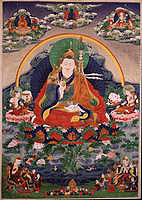
|
Guru Rinpoche Padmasambava (painting no. 188)
|

View Larger Image |
||||||||||||||
|
Guru Rinpoche Padmasambhava (Tibetan: pe ma jung ne, English: Lotus Born): the main founder of Buddhism in Tibet. With a steady composure gazing on all beings, white in colour with a reddish hue, one face adorned with a moustache and goatee, the right hand holds to the heart an upright gold vajra. The left hand placed in the lap holds a white skullcup filled with nectar, jewels and a long-life vase. The ornate katvanga staff of a Vajrayana mendicant decorated with white streamers rests against the left shoulder. Adorned with gold earrings and a necklace, the head is covered with a lotus hat, a gift of the King of Zahor, of silk brocade topped with a half-vajra and a single vulture feather. Attired in various robes of different colours reflecting the disciplines of the Vinaya, Bodhisattva and Mantra Vehicles, he sits atop a sun and moon disc above a multi-coloured lotus blossom rising from the blue waters of Dhanakosha lake; encircled by a rainbow sphere. Seated to the left is the consort Mandarava holding the long-life symbols of an arrow with a mirror and streamers in the right hand and a vase in the left. At the right is the cosort Yeshe Tsogyal holding up a skull offering bowl with the left hand. At the top center is the primordial buddha Samantabhadra, black in colour, naked, with the two hands placed in the lap and seated in vajra posture. To the left is Buddha Amitabha, red, holding a begging bowl in the lap with both hands; attended by two bodhisattvas. To the right is Padmapani (Lotus Holder) Avalokiteshvara, white with one face and two hands. The right hand performs the mudra of generosity while the left hand pressed against the seat holds the stem of a lotus blossom; attended by two bodhisattvas. At the bottom left is the pandita Shantirakshita, wearing the robes of a monk and a red pandita hat performing the mudra of explication. Seated with the legs pendant in a western style he is attended by two monks presenting offerings. (The monk holding the begging bowl is labelled with the name Dorje Dudjom inscribed with fine gold lettering). To the right is King Trisong Detsen performing the Dharma Teaching mudra while holding the stems of two lotus blossoms supporting a wisdom sword and book. The queen sits to the lower right while two laymen in front present offerings. In between the ground is strewn with heaps of wishing jewels, precious objects and a gold Dharma Wheel. "Miraculous buddha arising from a lotus, unborn, undying, possessing a vajra body, performing the activity of all buddhas of the three times; homage to Padmasambhava." (Nyingma liturgical verse). Principal among the many teachers to bring Buddhism to Tibet in the 8th century, Guru Rinpoche has numerous forms representing outer, inner and secret aspects. Within the Kama (Oral) Tradition of the Nyingmapa School, Padmasambhava was born in Northern India as the son of a king or minister. In the Terma (Treasure) Tradition he was born on a lotus in Dhanakosha lake as an emanation of the Buddha Amitabha. The four small attendant figures at the bottom of the painting have name inscriptions written in fine gold lettering (illegible). Jeff Watt 10-98
|
|||||||||||||||
Photographed Image Copyright © 1998 Shelley & Donald Rubin Foundation
|
|
| |
Next Image |